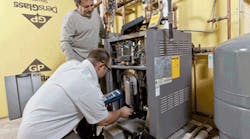KILLINGTON, VT. — Plagued with Legionella bacteria infestation, copper looting and unabated mold growth, the 97-room Cortina Inn here was in need of an overhaul. Among the needs: an entire heating and domestic water supply makeover.
Originally constructed in 1968 with additions in the following decades, the Cortina Inn tested positive for Legionella bacteria in 2008. The hotel sat vacant for two years before the current owner purchased it in a badly neglected state. While abandoned, copper thieves stole all of the large hot water mains. With every puncture to the service lines, water at 50 PSI soaked the entire structure. This led to pervasive mold growth; times were bleak for the once-majestic Cortina Inn.
Multi-faceted retrofit
“The renovation was an extensive project for everyone involved, but for us, there were two main goals,” said Steve Ellerin, president of Excel Plumbing & Heating. “First, restore the entire plumbing and heating systems, and then mitigate the Legionella bacteria problem. The owner of the hotel didn’t want a full-blown engineering project, so, we settled on an open-book, time and materials contract.”
Based in Rutland, Vt., the 11-person Excel crew has focused on residential and light commercial work since 1990.
Two huge oil-fired cast iron sectional boilers were still used for space heating in ’08, before the hotel closed its doors. The boilers were installed in 1987 when the last building addition was completed. They were connected to small hydronic coils within individual PTAC units in each of the guest rooms. For the domestic hot water, two 650,000 Btuh gas boilers heated 300-gal. indirect storage tanks.
One of the early tasks was to replace the stolen 2½-in. hot water mains. Then, Excel crews focused their attention on installing smaller piping components and all bathroom fixtures.
As work at Cortina Inn progressed, all four boilers and the indirect tanks were pulled out of the mechanical room and replaced with new equipment. In their place, five 100-gal., 199,000 Btuh Bradford White eF water heaters with a thermal efficiency up to 99.1% were installed to provide domestic hot water for the building. The units were selected because they were big enough to handle the load but small enough to avoid needing an ASME boiler stamp.
“By avoiding larger units, the hotel owner and maintenance crews have one less thing on their already-full plate,” added Ellerin. “The new gas fired water heaters are infinitely more efficient and dependable than the original units.”
Next to the water heaters in the mechanical room are two gas-fired, low NOx Laars NeoTherm boilers. The 95% efficient, modulating-condensing boilers are twinned for lead-lag sequencing, providing a combined 400,000 Btuh for the five new, common area fan coil systems.
Four 7½-ton units were salvaged before the remodel, and reinstalled.
“Two new units were also installed in the lobby and other common areas,” said Ellerin. “One was a roof-top model that we actually installed on a concrete pad on the ground, and the other was a 7½-ton air handler with a hot water coil.”
The mechanical room is centrally located within the 500-ft. hotel. One main goes east, the other west, each equipped with a Taco 2400 circulator.
“We chose the 2400 because it comes in many different configurations,” said Ellerin. “We were able to order the pump to precisely meet our flow rate and head loss.”
Excel used a primary/secondary piping configuration. Ellerin set up the two boilers to inject heat into a primary distribution supply and return main with each fan coil being served from secondary bridge piping.
Two closely spaced T’s and a Taco 007 circulator were used to distribute water to each air handler or cabinet heater. This allowed for the use of much smaller, more energy efficient pumps. In this way, each pump was merely required to meet the flow specifications of each individual fan coil.
To provide space heat for the guest rooms, the old, R-22 PTAC units in each room were replaced with propane-fired, direct-vent PTACs. The direct-vent units have a heat input of 14,000 Btuh each. Many of the rooms and common areas also have propane fireplaces.
“The project included a lot of gas piping. It ended up being about five million Btuh per hour in gas capacity,” said Ellerin.
Steel pipe made up the gas mains, while the individual rooms were connected with CSST flex pipe. The use of the PTAC units permitted dramatic reduction of the central boiler’s size.
Water safety
“If anything was sure from the beginning of the project,” continued Ellerin, “it was that legionella had to be controlled. After all, the bacterial infestation is what brought the last property owners to their knees.”
There is no municipal water in the Killington area, and legionella is not uncommon in nearby wells, in small increments. The two wells on the Cortina Inn property are no exception. The presence of legionella bacteria is usually harmless, unless a cozy, “Petri dish” warmth is provided as the spawning ground. Bacterial reproduction reaches a fevered pitch at 100°F-110°F, a temperature range that also happens to be ideal for comfortable, safe domestic hot water recirculation systems. At one point, the Cortina Inn’s water supply caused sickness, though fortunately, there were no deaths. Thankfully, legionella bacteria were detected and the Inn was promptly closed.
Germ warfare
A key focus of the renovation was to solve the problem for good. Dan Dupras, a consulting engineer on the project, put his head together with Ellerin, Ravi Bhakta, the hotel owner, and Vince Scriboni at National Hot Water, the distributor for the heating equipment. Together, while focusing on the risk of bacteria within the hotel, they came up with a simple plan to keep the bacteria permanently at bay.
To make an effective bacterial barricade, the Inn’s mechanical systems team developed a two-stage battle plan, the first part of which was designed to deliver a powerful blow before they entered the building’s plumbing system.
Consulting engineer Roland Luxenberg helped Ellerin devise a system that would kill legionella bacteria in groundwater storage systems. Near the Inn’s groundwater wells, two 7,500-gal. underground storage tanks hold water before being tapped by the hotel. Installed in ’87, well water enters the first tank and overflows into the second. When needed, water was drawn from the first tank. With minimal agitation of the second tank, the water was allowed to stagnate — the origin of the legionella problem. After being chlorine-shocked and cleaned, the storage tanks were reinstated, but with a different pumping strategy. Now, water from the wells comes in as it had before, but water is drawn from both tanks at an equal rate, eliminating the stagnation problem.
Now, before entering the tanks, water is sent through a five-micron filter system, passes through a high-volume UV light treatment system, and is then chlorinated. To quell any concerns state inspectors or guests may have, Luxenberg developed a manual outlining daily, weekly, monthly and quarterly water testing that would be performed by Cortina Inn staff.
Inside job
“On the inside, the hotel is laid out in three giant domestic hot water recirc loops,” said Ellerin. Manipulating the use of each loop in accordance with hotel occupancy is hotel’s first defense against legionella.
The owners do not intend to have full occupancy of the hotel at any given time. Their “no-vacancy” limit is reached when two-thirds of the rooms are full. When the rooms fed by one of the recirculation loops are all unoccupied, the hotel maintenance staff heats things up.
A key is needed to unlock a box covering a bypass for the tempering valves. By bypassing the valves, 170°F water runs directly from the water heater through one of the hot water recirculation loop. Once the loop is flowing with the super-hot water, and water is circulated for an hour, each faucet and shower water fixture on the loop is opened for about five minutes, a process sure to kill any bacteria that may be present. The process is performed on a weekly basis.
“Getting the correct mixing valves was a real challenge,” said Ellerin. Vermont currently has more stringent lead-free laws than California. The 125-GPM, stainless steel tempering valves arrived months after being ordered. The project also took three stainless steel Taco 0011 circulators to be deemed entirely lead-free.
When it came time to do the final water testing in early December ’10, the hotel, and Excel, had their ducks in a row. All components were ready, the tanks were scoured and cleaned and the water lines shocked and flushed. But when the testing lab came to take samples the next morning, there was no water pressure. The two deep well pumps had stopped working overnight. One had been on the decline for some time the other failed abruptly, setting everything back.
After a two-week delay to install new well pumps, 10 water samples were drawn. All indicated negative for presence of legionella bacteria. The Inn was issued its certificate of occupancy on the December 29 th, 2010, and had guests for the New Year.
Related Articles:
Renovated Hotel Felix becomes Chicago’s first LEED Silver hotel
Related Articles:
Hotel Andaluz is sustainable, maintains historic charm



